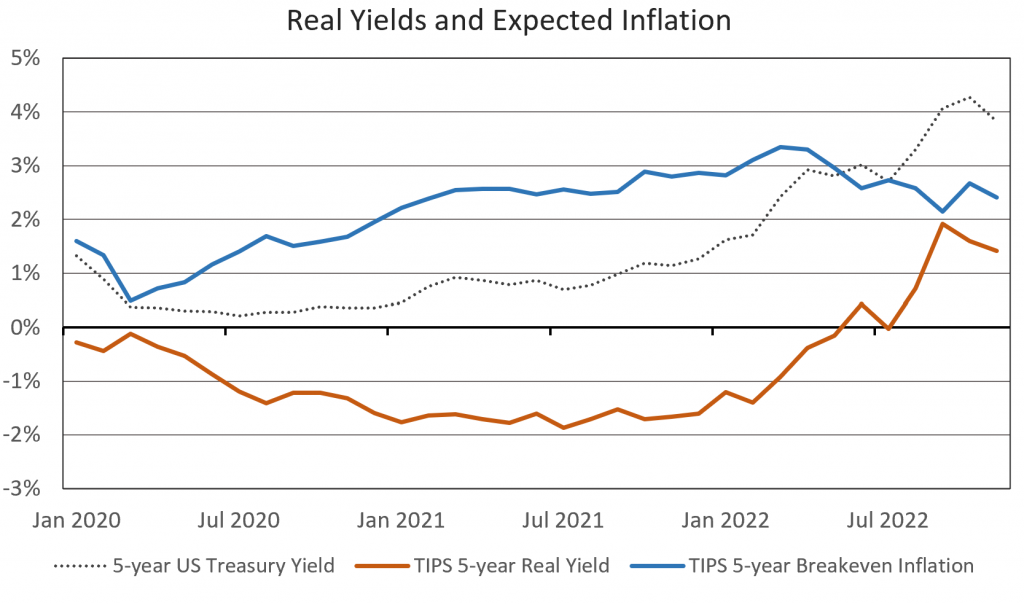2022 has been an unusually bad year for investment performance. While occasional large declines in stock prices are to be expected, a simultaneous large decline in bond prices is unusual. In fact, through the end of October, the investable U.S. stock market was down 18.8% for the year and the investable U.S. bond market was down almost as much, a whopping 15.7% drop.[1] This decline in the aggregate bond market is the worst performance of the last hundred years. It’s a shocking surprise for investors who have grown accustomed to bonds as a highly effective diversifier. For example, when the U.S. stock market melted down with a -37.0% return in 2008, the bond market offset some of these losses with a 5.2% gain.
So, what’s different in 2022?
Blame is being placed at the feet of unexpectedly high inflation and the Federal Reserve’s response with an aggressive policy of interest rate hikes. Granted these are larger and faster rate increases than expected, but currently the peak Fed Funds rate is only expected to be around 5%.[2] While this is well above the rates experienced in the last decade, it is about where the Fed Funds rate was in 2006 and just slightly higher than the 50-year average. It’s reasonable to then ask if the markets’ declines can really be primarily driven by changes in interest rates? In fact, the answer is yes. More specifically, the decline in investment asset values can be attributed almost entirely to a rise in the “real” interest rate which is adjusted for future inflation expectations. Let’s explore this further.
The graph below shows the path of the yield on the benchmark 5-year US Treasury Note over the last 3 years (dotted line). Yields were very low (less than 0.5%) in 2020 after the COVID-19 pandemic hit the U.S. and the Fed undertook quantitative easing policies to deliberately depress intermediate and long-term interest rates. In 2021, the 5-year yield drifted up some to about 1.25% by year end. But it wasn’t until this year that the 5-year yield really jumped—to around 4%.
One of the nice things about the U.S. Treasury market is the existence of Treasury Inflation Protected Securities (TIPS), which have their principal payments indexed to inflation (the Consumer Price Index, to be precise). As a consequence, the yield on TIPS is a “real yield” in the sense that it is adjusted for expected future inflation.[3] Another feature of TIPS is that the difference between the regular Treasury note yield and the same maturity TIPS yield provides a measure of expected inflation.
The graph below shows both the 5-year real interest rate (orange line) and the expected average inflation rate over the next 5 years (blue line). The patterns here are important for understanding this year’s market returns this year. During 2020 and 2021, real yields fell to close to -2% which is a record low for the U.S. As it became obvious that the Fed would have to wage an aggressive and sustained battle against inflation, real rates jumped sharply in 2022 to almost 2%. This swing in rates of more than 3% is the second largest increase in real rates since the TIPS market was formed (the largest being a brief spike during the global financial crisis when bond markets were disrupted).

In contrast, the blue line shows that inflation expectations have followed a very different path over the last 3 years. Inflation expectations dipped to under 1% as the economy fell into the pandemic-related recession in the first half of 2020. Inflation expectations then increased steadily in the second half of 2020 and all of 2021 before peaking at about 3.25% earlier this year. Yet, this year as real rates spiked and markets pulled back, 5-year inflation expectations have moderated quite a bit. Why is this? There are two primary reasons. For one thing, the worst of the energy price spike hopefully seems to be behind us. More importantly, the market appears to believe the Fed will in fact do what it takes to keep long-term inflation under control. While it may have appeared to the market that the Fed was behind the curve early in the year, they have reasserted their credibility on price stability with their aggressive tightening policy.
How does this explain investment returns?
My contention is that the change in real rates explains all of the decline in overall stock and bond prices. To understand why, it is illustrative to do some basic valuation calculations. Valuation of assets can be done any number of ways, but at a fundamental level, investors must believe that an asset’s value is equivalent to the discounted value of future cash flows the asset is expected to provide. The simplest example of this type of valuation is a “zero-coupon” bond that’s only cash flow is a principal payment at the bond’s maturity date.
Let’s consider a hypothetical zero-coupon bond that matures in 7 years (the average duration of bonds in the US) and will pay $100 in principal. Using an interest rate of 1.4% (the 7-year US Treasury rate at the beginning of 2022), the discounted present value (P) of this bond is
P = $100 / (1 + 0.0142)7 = $90.60
Now consider what happens to the bond’s value if interest rates increase to 4.10% (the 7-year US Treasury rate at the end of October). The bond’s price will fall to
P = $100 / (1 + 0.0410)7 = $75.48
which is a -16.7% decline in price – very close to the overall decline in the bond market year-to-date through October. Note that, as discussed above, this year-to-date change in rates is due entirely to an increase in real interest rates.
This example shows that changes in bond values in 2022 can be explained by changes in real rates, but what about stock prices? It is harder to accurately value stocks than bonds because the amount and timing of future cash flows from stocks are so uncertain. However, we can make some back-of-the-envelope calculations to get a sense of what the valuation effect should be from the change in real rates. The easiest way to do this is using the Gordon Growth Model for stock valuation, which assumes stocks (e.g., a stock index like the S&P 500) pay a regular dividend that grows at a constant rate forever. In this very simplified case, the fair price of the stock will be the next dividend amount (D) divided by the difference in the discount rate (r) and the dividend growth rate (g). Assuming we started 2022 with an expected dividend amount of $5 (that will grow 3% annually) and a discount rate of 8%, then the price of this stock would be
P = D / (r-g) = 5 / (0.08 – 0.03) = $100.00
Now let’s consider what would happen to the price if the discount rate increased from 8% to 10% — roughly the amount that very long-term real rates have increased this year.[4] The price of the stock would then fall to
P = D / (r-g) = 5 / (0.10 – 0.03) = $71.43
which is a decline of 28.6% — even more than the overall U.S. market has fallen this year.
These basic calculations illustrate how the decline in prices of stocks and bonds, and in fact any financial investment, have been heavily impacted by the substantial jump in real interest rates in 2022. The good news is that real rates have leveled off over the last couple of months at roughly their long-run average, so the pain inflicted by the large and rapid rise in real rates may be behind us.
[1] As proxies for the investable markets, I am using the Vanguard Total Stock Market Index Fund (Admiral Shares) and the Vanguard Total Bond Market Index Fund (Admiral Shares).
[2] See: https://www.atlantafed.org/cenfis/market-probability-tracker.
[3] As an aside, economists believe that real yields are the most important rate for determining the behavior of consumers and businesses because they describe the trade-off between actual purchasing power between now and a future date.
[4] For example, the real-yield on 30-year TIPS jumped from -0.44% on December 31, 2021 to 1.69% on October 31, 2022, an increase of 2.13%. See, https://fred.stlouisfed.org/series/DFII30.

Why Are All Investments Down In 2022? It’s All About “Real Rates”